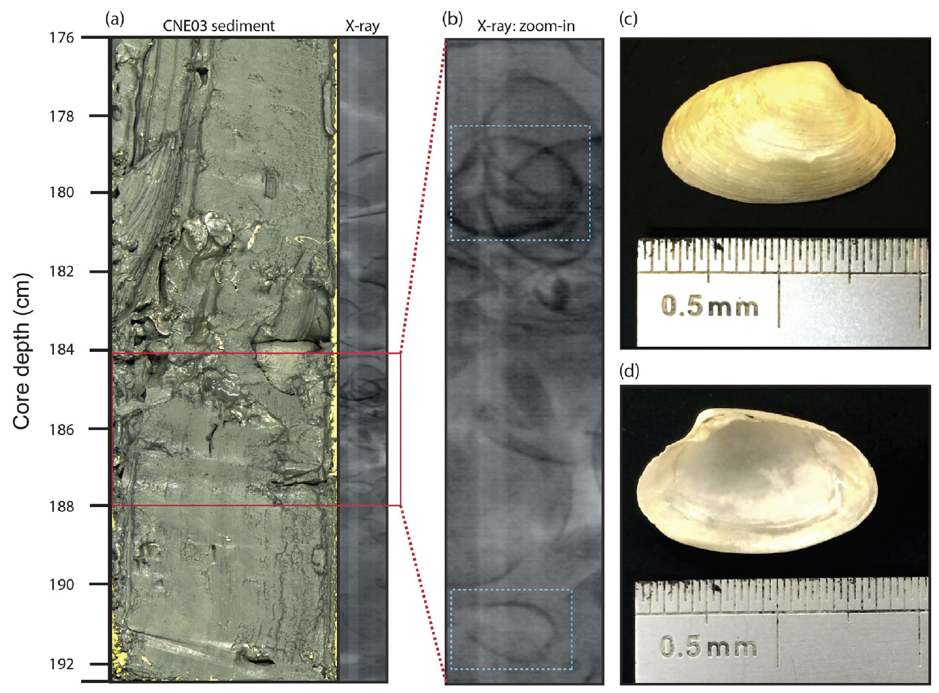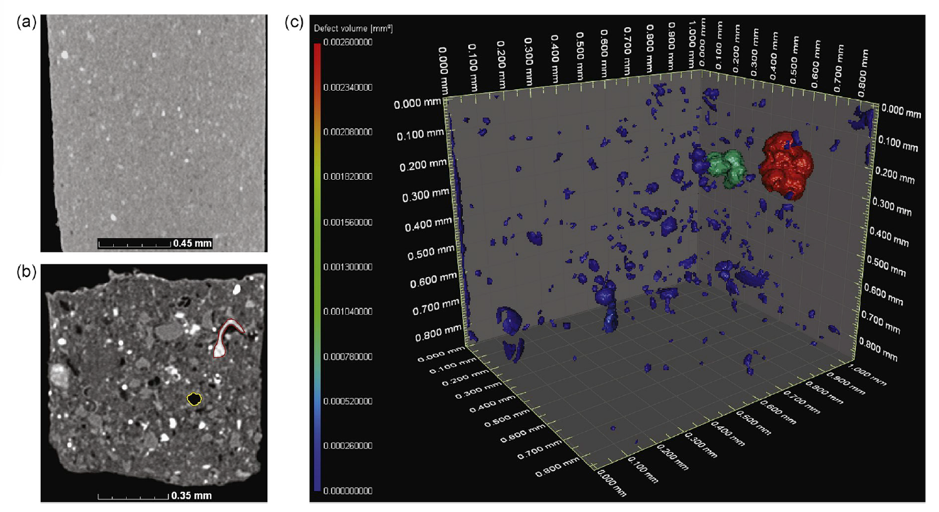A new paper utilising BOSCORF sediment cores was used to confirm the presence of gas hydrates in pockmark CNE03 from the Nyegga pockmark field, Nordic Seas. The paper, led by Dr Eric Attias (Hawaii Institute of Geophysics and Planetology), was co-authored by BOSCORF Deputy Curator, Dr Millie Watts who completed the analysis and interpretation of the sediment cores. The novel approach of this paper combined near surface observations of a sediment core that had contained hydrate on collection (as observed during cruise 64PE391, see Image 1, courtesy of Professor Dave Tappin, BGS), allowing a macro-, meso- and micro scale characterisation of the sediments of Nyegga pockmark, which were used to validate the CSEM (Controlled Source Electro-magnetic) and seismic model. A background core collected from 200m outside the pockmark was also used to validate the model and for additional analysis in BOSCORF.
Analysis of the sediment core at BOSCORF included observations from the MSCL-standard logger for physical properties before splitting, visual logging and identification of discrete horizons containing carbonate nodules and intact shells of the chemosynthetic species Isorropodon nyeggaensis, indicating periods of more intense methane venting within the pockmark since the end of the last glacial period. These shelly horizons were well imaged using a high resolution X-ray scan from the BOSCORF Itrax core scanner (Image 2).


This combination of observations at multiple scales has provided important constraints for model inputs, and to create a fully connected three phase model to represent pore-filling methane hydrate morphology (Image 3). The cores (64PE391_PC13 and PC14) remain part of the BOSCORF collection and are available for further study. Please contact boscorf@noc.ac.uk.
Reference:
Eric Attias, Kelvin Amalokwu, Millie Watts, Ismael Himar Falcon-Suarez, Laurence North, Gao Wei Hu, Angus I. Best, Karen Weitemeyer, Tim A. Minshull, Gas hydrate quantification at a pockmark offshore Norway from joint effective medium modelling of resistivity and seismic velocity, Marine and Petroleum Geology, Volume 113, 2020, 104151, ISSN 0264-8172, https://doi.org/10.1016/j.marpetgeo.2019.104151. (http://www.sciencedirect.com/science/article/pii/S0264817219306038)
Abstract: Methane emissions from gas hydrate deposits along continental margins may alter the biogeophysical properties of marine environments, both on local and regional scales. The saturation of a gas hydrate deposit is commonly calculated using the elastic or electrical properties measured remotely or in-situ at the site of interest. Here, we used a combination of controlled-source electromagnetic (CSEM), seismic and sediment core data obtained in the Nyegga region, offshore Norway, in a joint elastic-electrical approach to quantify marine gas hydrates found within the CNE03 pockmark. Multiscale analysis of two sediment cores reveals significant differences between the CNE03 pockmark and a reference site located approximately 150 m northwest of CNE03. Gas hydrates and chemosynthetic bivalves were observed in the CNE03 sediments collected. The seismic velocity and electrical resistivity measured in the CNE03 sediment core are consistent with the P-wave velocity (VP) and resistivity values derived from seismic and CSEM remote sensing datasets, respectively. The VP gradually increases (~1.75–1.9 km/s) with depth within the CNE03 pipe-like structure, whereas the resistivity anomaly remains ~3 Ωm. A joint interpretation of the collocated seismic and CSEM data using a joint elastic-electrical effective medium model suggests that for the porosity range 0.55–0.65, the gas hydrate saturation within the CNE03 hydrate stability zone varies with depth between ~20 and 48%. At 0.6 porosity, the hydrate saturation within CNE03 varies between ~23 and 37%, whereas the weighted mean saturation is ~30%. Our results demonstrate that a well-constrained gas hydrate quantification can be accomplished by coupling P-wave velocity and CSEM resistivity data through joint elastic-electrical effective medium modelling. The approach applied in this study can be used as a framework to quantify hydrate in various marine sediments. Keywords: Gas hydrate; Marine CSEM; Seismic velocity; Effective medium modelling

